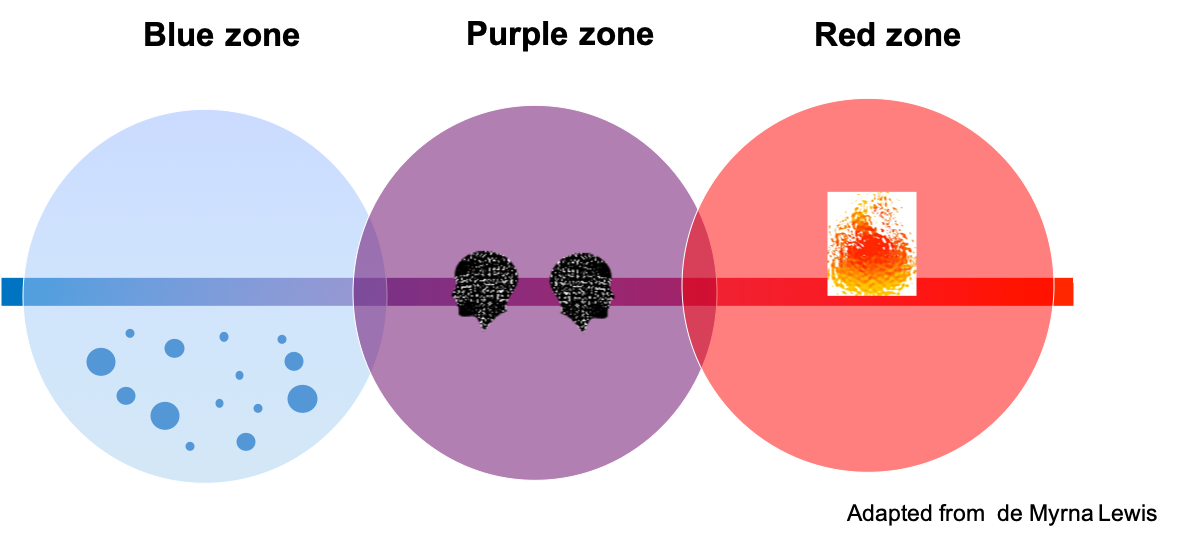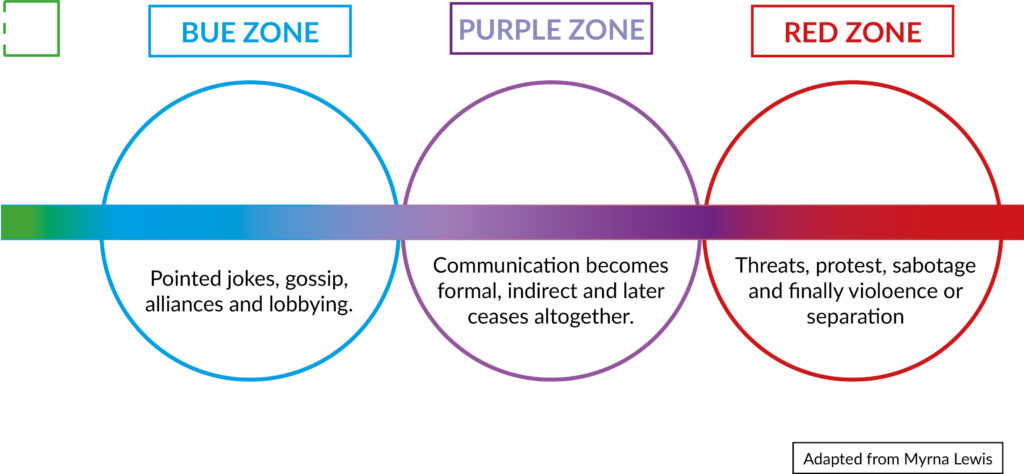Background Reading
On Polarisation and Conflict
You are welcome to use this matrial. Please be so kind as to credit the author and website.
On Polarity and Conflict
Bernard le Roux
For a facilitator, the concepts of polarity and conflict are of great importance. There may be different views on when a “disagreement” becomes a conflict, but it is of little importance. We rather need to understand why conflicts arise and how they escalate. Without this knowledge, the facilitator risks missing the opportunity of moving a conversation towards a constructive conclusion and in some cases may even contribute to a destructive conflict climate.
In this text, we shall briefly introduce our perspective on polarity and conflict.
Polarity
We assume that every perspective or view will naturally be accompanied by its opposite. Even where there is complete unanimity in a group, we can safely assume that there is a “no” to be found, if not in the room, somewhere beyond its walls. The “no” might be an outright opposition but could also consist of doubt or uncertainty.
We develop this idea of the “no” or polarity to the “yes” in the discussion on Inclusion under Meta-skills. You may ask, why do we need to make this assumption? Why do we need to consider polarity when there is agreement? Is it not agreement we seek as facilitators? This is an important question and leads us to a central principle in our facilitation model: the essential goal of creating clarity.
The existence of polarities is clearly linked to the primary task of the facilitator of dialogue namely to create clarity. If we simply assume that a majority of supporting votes (even unilateral agreement) is sufficient to carry a decision, we risk marginalising the minority voice. It is this marginalisation that is at the root of many conflicts that arise in society, in organisations and in other groupings.
For example, when a group takes a vote on an issue – let us say a project to provide jobs – a majority might vote “yes” and a minority “no”. The minority might have legitimate concerns about who is included in the project and who is excluded. But they dutifully “submit” to the “will of the majority” (being good democrats and all). The problem is that their legitimate concern might save the project a lot of trouble in the future. Some might even oppose the project and obstruct in some way or another. This could be avoided by finding a way to integrate the wisdom of their “no” into the decision.
It is not unusual in the broad area of facilitation that polarity (and conflict) is ignored or regarded as a matter for mediators or negotiators. We do not share this view and see it as essential for the creation of sustainable relationships and a sustainable society to be aware of and competent in handling both polarity and conflict constructively.
The polarity phase in a process
In our view of process and dialogue (inspired by Transformative Mediation and Deep Democracy) we recognise distinct phases in a process, be it a decision-making, exploratory, problem-solving, or other kind of process. We recognise that there is a stable, constructive (getting to-know-each other) phase, a phase of polarity when opposites start to surface and possibly give rise to tension and a phase where polarity is transcended. During the polarity phase, the group (even relationship, organisation, or society) faces a choice: to descend into conflict (and ultimately destruction) or to rise to the next level of development. This is a crucial choice and as facilitator, you need to be aware of it and, if possible, bring it to the group’s awareness.
Working groups often start off in a polite way, avoiding difficult issues. As the conversation continues, differences start to become apparent. As a facilitator, it is wise to recognise this as a normal and healthy phase of the process rather than an obstacle or problem. Polarity provides the opportunity for a group to transcend to the next level – ignoring the polarity and continuing to pretend that all is fine can launch the group into conflict.
Conflict
We regard conflict as a natural process in any living system. It is an opportunity for the development and growth of society, organisations and for relationships. Whilst polarity is an essential phase in a successful process, there is always the risk that such polarity can become a conflict if is not resolved or transcended.
This is perhaps rather too theoretical. Consider an example of a project that starts well. There are good intentions all around and communication between all involved parties is free from friction. Issues arise where parties are not in full agreement with each other, and some degree of tension arises. If this is not resolved right away, the tension will grow or surface in other issues. For us, this is quite natural. The tension is an indicator that some form of adjustment is necessary – either in the structure of the organisation, the flow of communication, the relationships, the goals or in the practical implementation of decisions. This is no problem if the issues are facilitated well and resolved. Should they however fail to be resolved, the ensuing conflict could have negative, even disastrous effects on the project.
Conflict can be described in a number of ways. We refrain from restraining ourselves to a formal definition but have been guided by two central thoughts: conflict as a natural result of marginalisation and conflict as a crisis in human interaction. We discuss these two in more detail below and include a section on two modes of thought.
Conflict and marginalisation
Deep Democracy (Mindell, Lewis) maintains that a voice or a perspective is excluded or marginalised in some way, tension arises. This tension can be regarded as one of the roots (if not the root) of conflict in group processes.
A perspective can be a point of view, an idea, a strong feeling, or emotion or even a role. People and groups are bearers of or give voice to perspectives. When such a voice is not taken seriously, not heard or outright excluded, tension rises.
The tension that is the result of a marginalised voice wanting to be heard takes on different forms of expression. As the conflict escalates the resistance becomes clearer and more visible outwardly. The level of escalation can be determined by looking at the signs or symptoms on a continuum.
For example, there are early signs of a rising conflict which we can group into what we call the blue zone. There are signs of the conflict intensifying that belong to the purple zone and clear signs that the conflict has taken on a serious form in the red zone.
In the diagram below, you can see some of the signs of an escalating conflict.
Consider a conflict that you are familiar with and see whether you recognise some of the mileposts.

A more detailed version

As a conflict can escalate because of marginalisation, it can also de-escalate when the marginalised voice begins to be included in the process. However, de-escalation of a conflict does not imply resolution. To understand how a conflict is transformed or resolved we need to return to the topic of process phases.
The inclusion of a person or group that feels that it is not recognised, not heard and not taken seriously is the first step in the process. It is not enough just to invite somebody to a meeting and hear them out. Those who are in power or in the majority need to mean, and not simply fake, openness. Once the parties are in the room, the facilitator has the difficult task of providing a safe space where all the parties can express themselves.
We have mentioned that a successful process moves into a phase of tension where the group faces a choice: descending into conflict or rising to the next level of development.
Let us use an example to illustrate this moment of choice: a project team is dominated by a strong leader with two or three supporting members. They make decisions for the group and largely disregard input from others. Discontent grows and the performance of the team diminishes. Fewer and fewer meetings are held as they have become tense and uncomfortable. Everybody is blaming the other for the problem. The moment of choice for the group is: a) to continue on this road and see the situation worsening, or b) to get to open up the conversation, get to the bottom of the problem and adjust the structure and power-relationship within the group.
In order to take this step (or leap), parties need to let go of their fixed positions and see the situation from the other’s vantage point. This transformation can lead to the parties gaining new insights into the situation allowing them to adjust to a new reality. This is where we move from being stuck, into a greater fluidity.
A process with the group shows that there is a lack of trust between the leadership and the rest of the team. The leader expresses his uncertainty by exerting control and the team feels that it has no influence. Bad decisions cannot be questioned. The team leader admits to his uncertainty and opens up for a new, more inclusive style of leadership.
Conflict as a crisis in human interaction
Transformative Mediation views conflict as a crisis in human interaction (Bush & Folger). As the quality of communication between the parties deteriorates, they lose their ability to resolve differences and overcome obstacles between them. They become more self-absorbed and less able to view both their own and the other party’s perspectives clearly.
This view emphasises communication between the parties. Good, open communication allows parties to resolve differences easily. When the communication becomes problematic, differences become obstacles and the negative spiral of tension and resistance continues to affect relationships.
From this point of view, the path to resolving the conflict leads through the improvement of the quality of the interaction between the parties. This is usually difficult for parties to manage themselves. A mediator or facilitator can assist the parties – not to find solutions to their problem, but by helping them free up the communication between them so that the parties themselves can find a good way forward.
Improving the quality of the interaction involves supporting openness and clarity (or empowerment and recognition as Bush and Folger describe it). In our example above, the decision to meet and discuss the problem in the team is the first step. The facilitator makes it possible for both parties to express themselves clearly and to move from taking fixed positions towards opening up to the other’s point of view.
As the communication improves, parties become more open towards each other and they become clearer regarding their own perspectives. The openness and clarity provide them with the basis for taking the next steps in the process. The facilitator does not guide, push or nudge them towards a settlement that she believes is beneficial. She allows them to make their own choices and their own decisions.
If, for example, a consultant had suggested “the solution” to the problem with the team in our example, questions may have been asked about who pays the consultant, whether she understands the situation and whether SHE is competent. She may be considered biased for supporting one or the other of the groups. If the parties themselves come to the insight that they need to change their behaviour, their attitudes and improve their relationships in order to achieve a common goal, the results are much more sustainable as they include all the involved parties.
